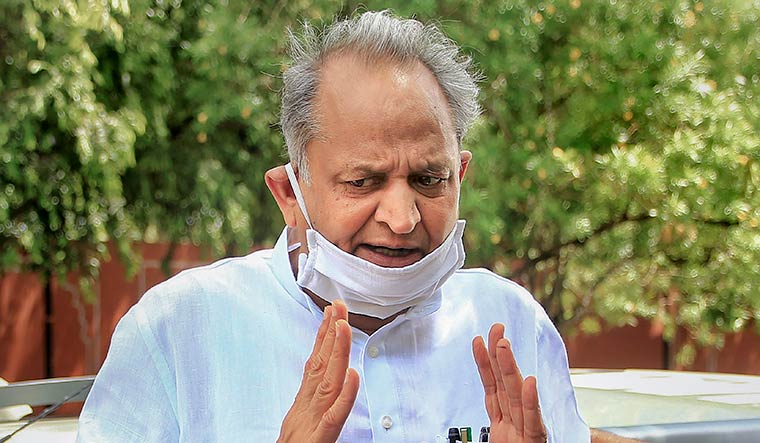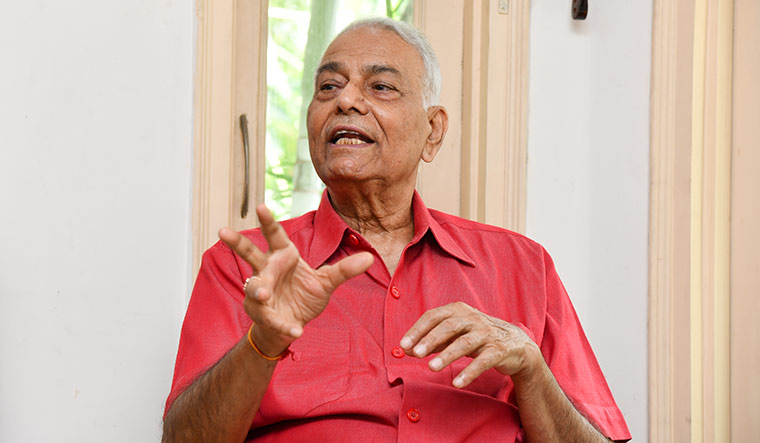Rajasthan Chief Minister Ashok Gehlot has let out a genie. His government recently announced that it was restoring the old pension scheme (OPS) for its employees, thereby discarding the contributory scheme that had come into effect after India initiated bold pension reforms nearly two decades ago. Several state governments, especially those ruled by parties opposed to the BJP-led Union government, are preparing to follow Gehlot’s lead.
Economists have pointed out that such a populist move would be retrograde, as it can drain state finances. Several states have latched on to the idea, though. In Congress-ruled Chhattisgarh, where the party’s flagship income guarantee scheme NYAY is being implemented for farmers and the landless, the restoration of OPS is set to become a pillar of the party’s evolving alternative economic model. The Congress has already promised to bring back OPS if it comes to power in Himachal Pradesh, where elections are due later this year.
DMK-ruled Tamil Nadu and YSR Congress-ruled Andhra Pradesh have also promised to revert to OPS. The Samajwadi Party’s campaign promise to restore OPS in the run-up to the Uttar Pradesh assembly polls helped it win a majority of postal votes (51 per cent) cast by government employees. For political parties, the electoral gains to be had from backing OPS seem evident now.
As the rising cost of living hits the middle class, OPS and the assured pension that comes with it (equivalent of 50 per cent of last-drawn pay) is an attractive proposition. Under the contributory scheme called National Pension System (NPS), which has been in effect since 2004, employees contribute 10 per cent of their monthly salary and the government pitches in with 14 per cent. The money goes to pension funds run by private companies. Once they retire, employees can withdraw 60 per cent of their contribution, while 40 per cent goes to annuity funds that provide monthly pension.
Because of several shortcomings, though, NPS has not been working well for employees, a good number of whom would start retiring in the 2030s. Vijay Kumar Bandhu, a teacher in Uttar Pradesh, has been fighting to get OPS restored. He is president of the National Movement for Old Pension Scheme, a nationwide organisation set up seven years ago. “We want social security, which is missing under NPS,” he said. “There are numerous examples of people retiring and getting very little. What we get is a pittance. Our pension is left at the mercy of markets. Only a few per cent of the country’s population invests in markets. If I retire at a time when there is a market crash, my pension money would also go down.”
Bandhu made several arguments against NPS—that the pension does not increase with subsequent pay commissions; there are few benefits in case of death while in service; and employees have to deal with private insurance companies, and not the government, in case of a dispute.
More than 78 lakh government employees (22.74 lakh at the Centre and 55.44 lakh in state governments) come under NPS. Their total contribution till February 28 this year has been Rs4 lakh crore. Reverting to OPS would mean that employees not contribute 10 per cent of their salary to the pension fund, while the government’s share be deferred and later paid as full pension.
According to the Reserve Bank’s 2019 report on state finances, the total pension bill was more than 04 lakh crore in the fiscal year 2021-22. Economists estimate that the figure would rise by more 6 per cent if OPS is brought back.
India’s pension reforms started almost inadvertently in 1998, when Union minister Maneka Gandhi set up a panel to implement ‘Project Oasis’—acronym for ‘old age social and income security’. The panel was chaired by Unit Trust of India chairman Surendra Dave, and its report was forwarded by Maneka Gandhi to finance minister Yashwant Sinha to take over the issue of pensions in its entirety.
“I examined India’s pension system in great detail,” recalled Sinha. “Everyone came to the same conclusion, that the Indian government would be paying more in pensions than in wages and salaries. This would have made the budget go haywire. With all studies backing that conclusion, we decided that instead of a fixed pension scheme, we should go for a contributory pension scheme.”
After consultations with prime minister Atal Bihari Vajpayee, Sinha gave shape to the scheme in his 2001 budget. Employees began joining the scheme from January 1, 2004. “We had proposed that we will make investments in stock markets and other financial instruments based on the choice made by the pensioners,” Sinha said. “If he wanted security, the money would be invested in government securities; or if he wanted take a little risk, in stock market.”
According to Sinha, the move to shift to OPS is retrograde. “OPS will, over time, make government finances unsustainable. State government finances are not always in the pink. They depend largely on Central funds. Therefore, if there is any extra burden, their financial situation would become unsustainable. It is long-term economic reforms versus populism,” he said.
Bandhu, however, argued that there would be no extra burden on state governments. “For example, there are 10 lakh employees in Uttar Pradesh under NPS. An employee pays 10 per cent of his salary, and the government contributes 14 per cent. This 24 per cent—which is government money—is given to private companies,” said Bandhu. “On an average, a UP government employee pays Rs7,000 to Rs8,000 a month as part of NPS. Multiply Rs8,000 by 10 lakh… look at the amount that is contributed. If the government were to use this money, and invest it by itself, it could foot the pension bill.”
But experts support Sinha’s view. “OPS is fiscally unsustainable because of demographic transition,” said Renuka Sane, associate professor at National Institute of Public Finance and Policy, Delhi. “There are more old people now. You are paying through the tax revenue system, as there is no contribution. Earlier, people would live five to 10 years post retirement. Now, people live 25 years post retirement. Then their family or spouse will live another five years. So the obligation on the government becomes huge.”
Sane pointed out that Rajasthan was spending more than 60 per cent of its revenue on wages and pensions. “So how is this fair that 6 per cent of the workforce gets 60 per cent of government revenue?” she asked. “That is something fundamentally wrong about this system.”
Various policy lacunae have created problems for NPS. The system was designed for those who join when they are 25, and then makes contributions to market-linked pension funds for 30 to 40 years. Serving employees who were 40 years or older were later forced to join NPS, which meant that they did not have adequate time to build a healthy pension fund. Another problem afflicting NPS, highlighted earlier by a report by the comptroller and auditor general, is that state governments have not been disciplined in making contributions to the pension funds.
The Union government has denied that it was considering restoring OPS. The Pension Fund Regulatory and Development Authority is apparently planning to come out with more attractive pension plans with an assured rate of interest for those who do not feel comfortable with market volatility.
“Look at how much pension a former MP or MLA gets,” said Bandhu. “In Punjab, former chief minister Parkash Singh Badal, who had been elected MLA several times, was getting Rs5.75 lakh a month as pension. The people who are getting pensions are saying that we should not get pension. MPs get Rs25,000 as pension for five-year terms, and another Rs200 extra for every additional year served.”
There have been many experiments with pensions in various countries since the idea of giving pensions was first proposed by German chancellor Otto von Bismarck in 1881. Governments are toying with different ideas to make pensions fiscally feasible. In that regard, the Indian experiment with NPS needs further tweaks.
“It has been 18 years [since the inception of NPS]; let’s look at how things have worked out,” said Sinha. “I strongly recommend that an independent committee be formed to look at the whole thing. Let them give a report to the government on the functioning of the new scheme. And if there are shortcomings, let them make recommendations on how it could be improved.”




